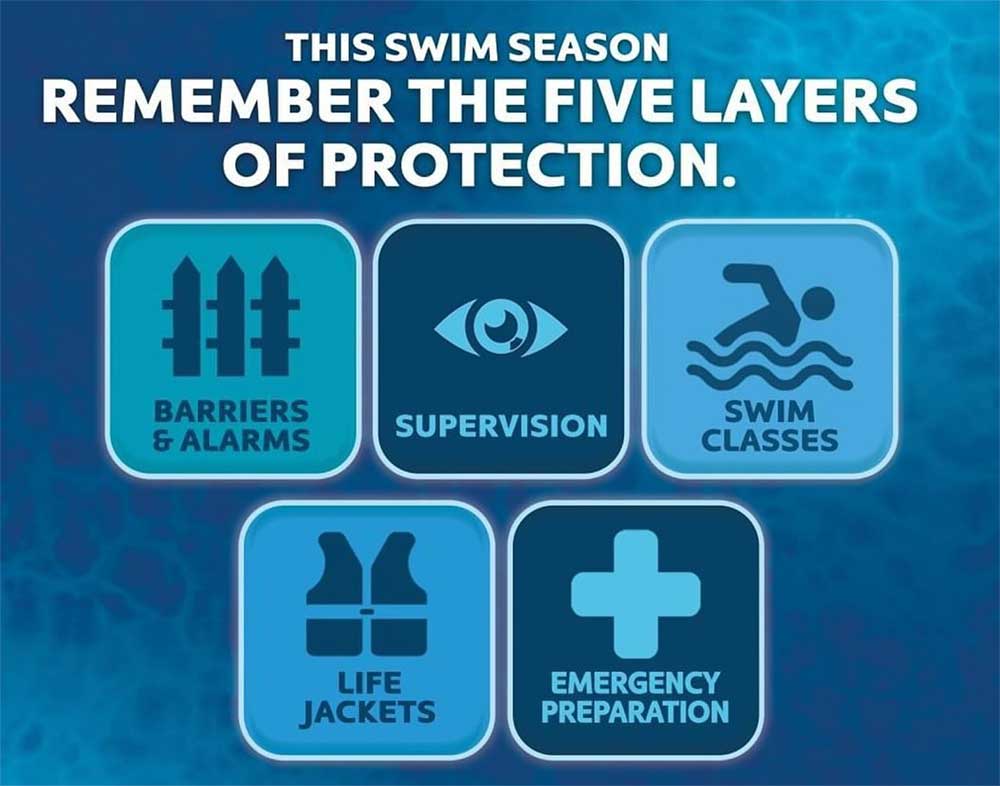(Tustin, CA – May 16, 2024) – In response to the CDC’s recently released Vital Signs report, the National Drowning Prevention Alliance (NDPA) remains active in addressing childhood drowning, working year-round to arm parents and communities with life-saving tools and resources while continuing to advocate the importance of the five layers of protection.
On May 14, 2024, the Centers for Disease Control and Prevention (CDC) released its report Vital Signs: Drowning Death Rates, Self-Reported Swimming Skill, Swimming Lesson Participation, and Recreational Water Exposure for the period 2019-2022. The report revealed that unintentional drowning deaths were significantly higher during 2020, 2021 and 2022 compared with those in 2019. Among the most alarming findings was the rise in drowning rates among children aged 1-4 which increased 28% in 2022 (compared with 2019); and the increases among Black and Hispanic persons across all ages, which rose by 28% (2021 vs. 2019) and 24% (2022 vs. 2019), respectively.
The release of CDC’s Vital Signs coincides with the continuous reports of drowning incidents nationwide during the first half of 2024, with some states reporting both fatal and non-fatal drownings at record levels.
“Of the many misperceptions about drowning, perhaps the most important to dispel, particularly as it relates to children, is that one strategy for prevention is enough,” said Adam Katchmarchi, Ph.D., Chief Executive Officer, NDPA. “It’s imperative that parents and caregivers practice multiple layers of protection because we know any one of them can fail at any time.”

NDPA encourages parents and caregivers to practice the Five Layers of Protection whenever a child is near open water to prevent a drowning incident. These include:
- Barriers and Alarms – to prevent children from gaining access to a pool or open water unsupervised.
- Supervision – close, constant, and capable adult supervision any time children are in or around water.
- Water Competency – basic water safety skills can help reduce the risk of drowning and aquatic-related injuries.
- Life Jackets (tested and approved by the U.S. Coast Guard) – to provide protection in and around open water.
- Emergency Response Preparedness – including CPR training with rescue breaths and having a phone nearby to call 911.
The CDC report also found that an estimated 40 million U.S. adults reported not knowing how to swim. Thus, NDPA is putting extra emphasis this summer on water competency with its summer-long #FirstSport campaign to change the trajectory for the next generation. The #FirstSport campaign includes a public service video (click here to view/download) which launched on May 1 and has been shared across social media by parents, advocates, athletes and celebrities alike. In addition to the Five Layers of Protection, the video encourages parents to make swimming the #FirstSport they teach their child, because it is the only sport that provides kids with life-saving skills. Non-swimming parents are also encouraged to gain basic water survival skills to better protect themselves and their children.
To date, NDPA’s efforts to educate parents and the public at large have been gaining traction in actioning parents around childhood drowning prevention. In two weeks, the #FirstSport video has received more than one million views on social media, while NDPA’s water safety tool kits, checklists, and online resources have received close to 20,000 downloads since January 2023.
“Too many of our children are lost to drowning each year, but we need to keep in mind that drowning is accidental and can be prevented,” said Adam Katchmarchi, Ph.D., Chief Executive Officer, National Drowning Prevention Alliance. “We invite the public at large to join us in protecting kids from drowning by watching and sharing the #FirstSport video, becoming water competent themselves, and always practicing the Five Layers of Protection. By adopting the Five Layers of Protection when enjoying a backyard pool, at the beach, or when a child is exposed to open water, parents have the power to prevent drowning.”
According to the CDC, drowning remains the leading cause of death among children aged 1-4. Data also shows that 69% of drowning incidents involving young children occur during non-swim times when a child is drawn back to the water and there are no barriers or adults present, and that teaching a child water competency can help reduce the chances of drowning by as much as 88%.
The post NDPA Responds To Release of CDC Report Citing Rise in Drowning Death Rates appeared first on PoolMagazine.com – Get The Latest Pool News.








